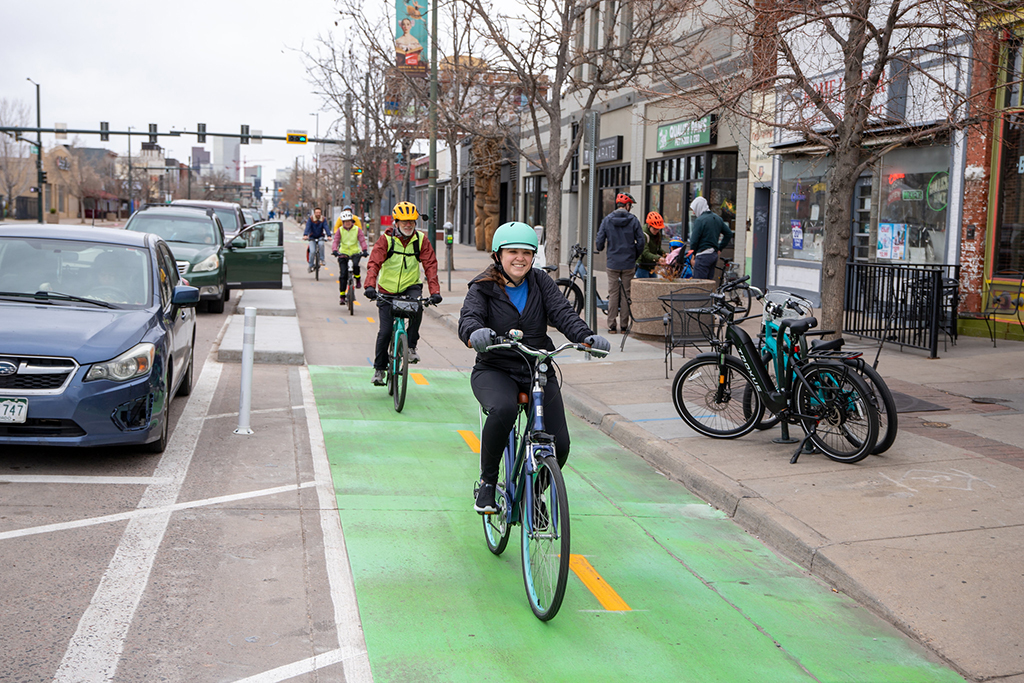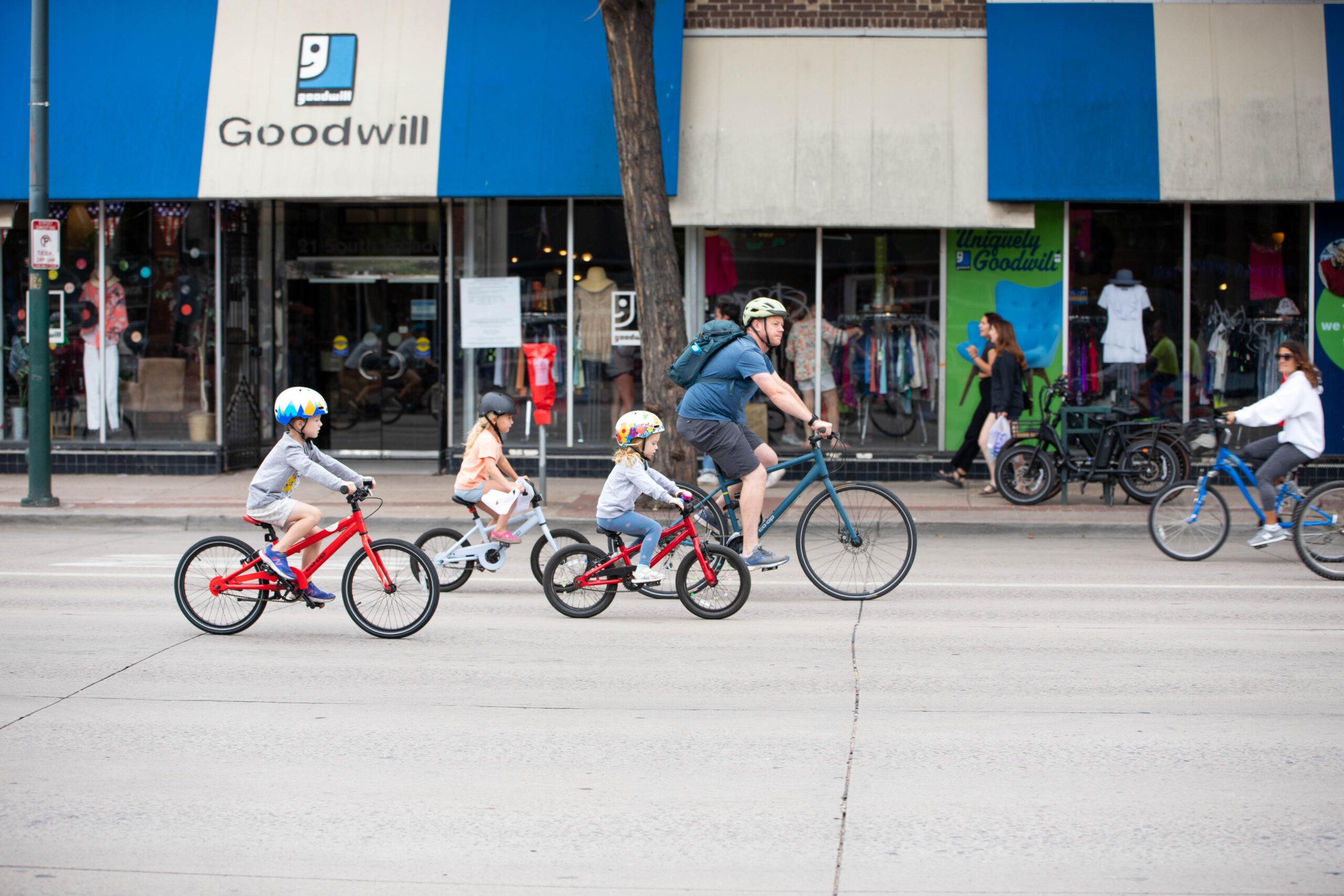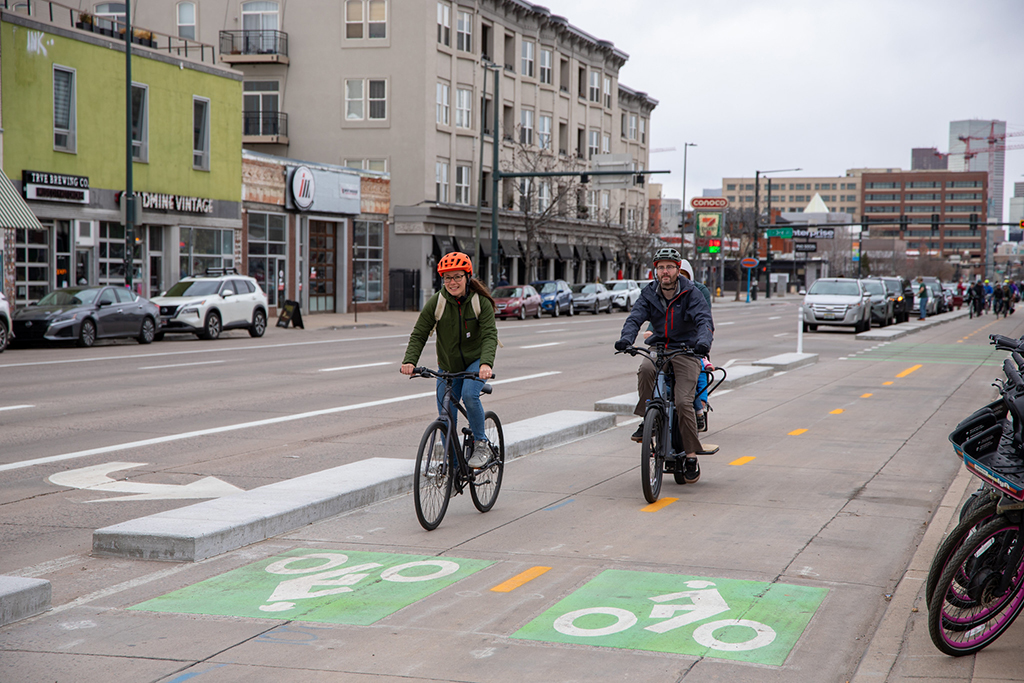
It is hard to believe, but after almost 10 years of planning, the Broadway Bikeway has finally been completed! Multimodal projects like the Broadway Bikeway are major milestones in making Denver a safer and more connected place to bike, walk, use transit, and drive, plus they have great potential to increase retail revenue for businesses. Read on for more details on why the Broadway Bikeway is so important, how we got to this milestone, and all the street enhancements included in the final project.
Check out the full photo album from our Broadway Bikeway Celebration on Saturday, April 6, 2024!
The effects of bike infrastructure
More safety on roadways
Across the United States, protected bike lanes (like the Broadway Bikeway) have been proven to increase safety for not just people biking, but for people driving as well.
- In New York City, a protected bike lane led to a 56% reduction in crashes resulting in injury for all road users, a 57% decrease in crashes involving people biking, and a 29% reduction in crashes involving people walking.
- A 2019 study of 12 cities (including Denver) revealed that cities who built protected and separated bike infrastructure had 44% fewer traffic deaths than the average city.
- Perception of safety on roadways from people who bike also drastically increases with the addition of protected bike lanes. A 2014 study of six cities in the U.S. found that 96% of people biking surveyed and 79% of surveyed residents stated that the installation of the protected lane increased the safety of bicycling on the street. And that 89% of surveyed bicyclists agreed that the protected bike lanes were “safer” than other bike lanes in their city.
More retail revenue and business visibility
Contrary to perceptions that removing parking and adding bike lanes may be a deterrent to business and foot traffic on commercial streets, there are many success stories of increased revenues and foot traffic following the implementation of a protected bike lane near high-density business areas. PeopleForBike’s 2023 report, Protected Bike Lanes Mean Business, is full of these stories.
More connectivity to important destinations
With the recent completion of the Denver Department of Transportation & Infrastructure (DOTI)’s Broadway Bikeway project, several pre-existing bikeways and trails are now properly connected. South Broadway now fully connects to the Cherry Creek Trail, which connects to Downtown Denver, Cherry Creek Shopping Center, and other amenities along Cherry Creek Trail. The Broadway Bikeway also fully connects to the new 7th Street Neighborhood Bikeway and Bayaud Neighborhood Bikeway. Finally, people biking can experience a comfortable ride along Broadway and connect to neighborhood bikeways that lead to Cheesman and Washington Park. And, while there is still much to be desired, the new Broadway Bikeway provides improved access to I-25 & Broadway RTD Station.
It is also crucial to note the significance of a bikeway on a street like Broadway, the first major arterial street in Denver to have protected bike infrastructure. Arterial streets make up the bulk of Denver’s High Injury Network, because they’ve been designed like highways to prioritize cars over all other modes of travel. Reallocating space for people walking, biking, and taking transit is exactly how we can transform these deadly streets into truly people-friendly main streets that connect directly to daily destinations, rather than forcing people outside of cars to take more indirect routes. Broadway is now a fully multimodal corridor, and one of the few roads in Denver that has a protected bike lane, bus priority lanes, and travel lanes for vehicles.
On South Broadway…
What did it take?

Like many major street transformations, this project jumped through several planning and funding hoops in order to bring safe biking infrastructure to South Broadway. Below are the major milestones in the Broadway Bikeway project, which required persistent advocacy from community members every step of the way.
2015
DOTI began studying both Broadway and Lincoln to increase safety for people walking, biking, driving, and taking transit. A major recommendation from the Broadway/Lincoln Corridor Study was a two-way, parking-protected bikeway on the east side of Broadway.
2016
From suggestions in the study, the City constructed a pilot two-way, protected bike lane along Broadway, from Virginia to Bayaud, to evaluate traffic operations and determine the feasibility of a permanent bikeway along Broadway. Behavior of people walking, biking, and driving was studied across the corridor for the duration of the pilot program—highlights can be found in the Broadway Bikeway Evaluation.
2017
Denver voters approved Elevate Denver, a general obligation bond initiative that would fund $937 million of projects, with $431 million going towards transportation and mobility projects like the Broadway Bikeway.
2019–2022
Conceptual design and planning for the bikeway are underway.
Fall 2022
Bikeway construction begins.
Winter 2023
Bikeway construction is completed.
What’s changed exactly?

The infrastructure improvements along Broadway go well beyond a simple protected bike lane. The Denver Moves: Broadway Project was expansive, and included a variety of much-needed infrastructure and safety improvements for multiple modes of travel along the corridor.
Two-way, protected infrastructure
The bi-directional bikeway extends from 7th Ave to Center Ave and includes concrete curbs to protect people in the bikeway from vehicles traveling on Broadway. The bike lane is painted with “mixing zone” areas (green dashed paint) to signify where cars can cross the bike lane.
Pedestrian enhancements
Throughout the corridor, new sidewalks and ADA-accessible curb ramps at intersections were added to improve safety and comfort for people of all ages and abilities walking along Broadway. At some intersections, pedestrian refuge islands were added between the bikeway and travel lanes. These additions reduced the distances pedestrians have to cross car traffic by over 10 feet.
New signals
At every signalized intersection along Broadway, new bicycle and vehicle signals were added. The signal timing allows people in the bikeway to continue on Broadway at the same time as southbound traffic. With the addition of the bike signal, Broadway also has new left-hand turn signal timing. Cars turning left to travel east are required to wait through the bike light timing, then proceed once they are given a green arrow.
Wayfinding signage
Several new wayfinding signs have been added along the bikeway to show the direction and distance to important connections like the Cherry Creek Trail and I-25 & Broadway RTD Station.
Streetscaping and public art
These enhancements were not a part of the first construction phase, but streetscaping and public art improvements have been identified along the corridor to complement Broadway’s culture and character.
Take a virtual tour of the new infrastructure in this 5-minute YouTube video!
The safety improvements included in this roadway project are a marker of Denver’s priorities and willingness to improve transportation access for people outside of cars. It certainly did not happen overnight, and it’s vital to reflect on everything that led up to the completion of this bikeway in order to replicate similar projects in the future and achieve our vision of safe and accessible streets for all.
